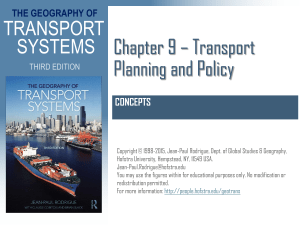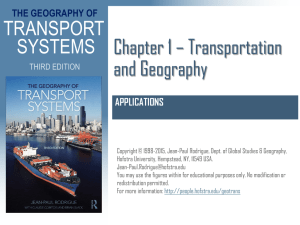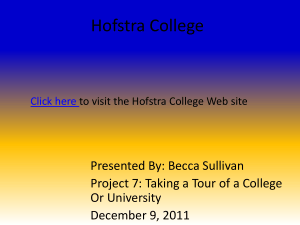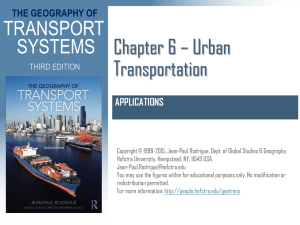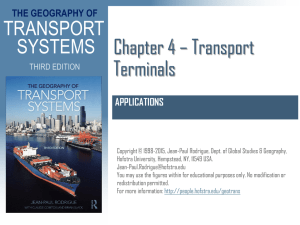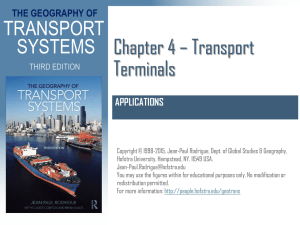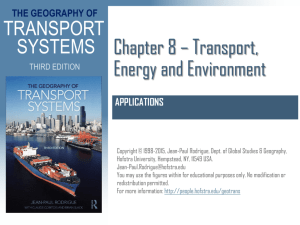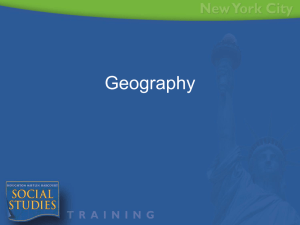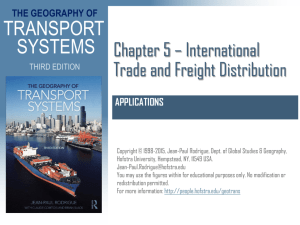Chapter 9 * Transport Planning and Policies
advertisement
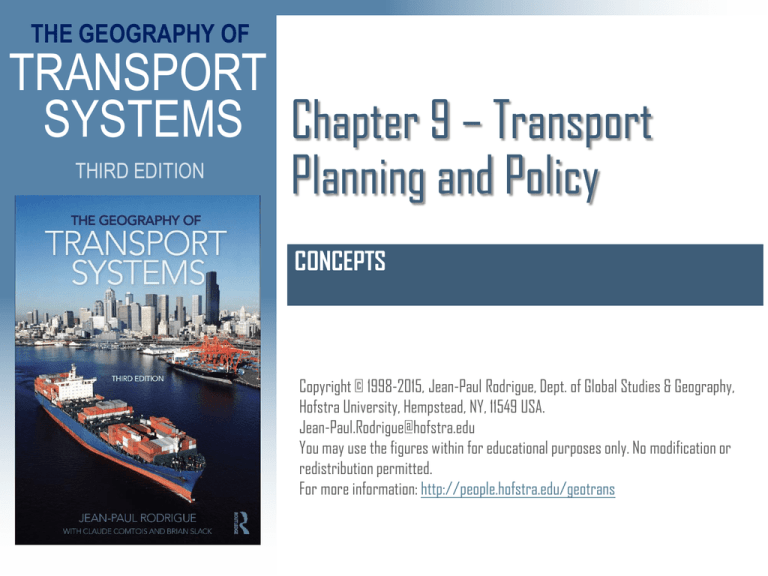
THE GEOGRAPHY OF TRANSPORT SYSTEMS Chapter 9 – Transport THIRD EDITION Planning and Policy CONCEPTS Copyright © 1998-2015, Jean-Paul Rodrigue, Dept. of Global Studies & Geography, Hofstra University, Hempstead, NY, 11549 USA. Jean-Paul.Rodrigue@hofstra.edu You may use the figures within for educational purposes only. No modification or redistribution permitted. For more information: http://people.hofstra.edu/geotrans Usage Conditions • DO NOT COPY, TRANSLATE OR REDISTRIBUTE THIS DOCUMENT. • The contents of this document can be freely used for personal or classroom use ONLY. • Although the material contained in this document is freely available, it is not public domain. Its contents, in whole or in part (including graphics and datasets), cannot be copied and published in ANY form (printed or electronic) without consent. • If you have accessed this document through a third party (such as a content farm), keep in mind that this party is illegally redistributing this content. Please refer to the true source (http://people.hofstra.edu/geotrans) instead of the third party. • Permission to use any graphic material herein in any form of publication, such as an article, a book or a conference presentation, on any media must be requested prior to use. • Information cited from this document should be referred as: Rodrigue, J-P et al. (2013) The Geography of Transport Systems, Hofstra University, Department of Global Studies & Geography, http://people.hofstra.edu/geotrans. Copyright © 1998-2015, Dr. Jean-Paul Rodrigue, Dept. of Global Studies & Geography, Hofstra University. For personal or classroom use ONLY. This material (including graphics) is not public domain and cannot be published, in whole or in part, in ANY form (printed or electronic) and on any media without consent. This includes conference presentations. Permission MUST be requested prior to use. THE GEOGRAPHY OF TRANSPORT SYSTEMS The Nature of Transport Policy THIRD EDITION Concept 1 Copyright © 1998-2015, Dr. Jean-Paul Rodrigue, Dept. of Global Studies & Geography, Hofstra University. For personal or classroom use ONLY. This material (including graphics) is not public domain and cannot be published, in whole or in part, in ANY form (printed or electronic) and on any media without consent. This includes conference presentations. Permission MUST be requested prior to use. Main Involvement Sectors for Public Policy Sector Categories Regulatory Policy Financial regulation; Antitrust laws and regulations; Effective legal enforcement; Product liability laws; Tort law; Ease of doing business Infrastructure Policy Water; Transportation; Electric; PPP; Broad investment support Labor Policy Wages; Benefits; Labor unions; Workplace safety; Discrimination; Severance; Worker rights Science & Technology Intellectual property; Information security; Technology transfers; Investment & support Economic Development Export-import bank; Export incentives/restrictions; Strategic industries; Small & medium-sized enterprises; Special economic zones Energy & Environmental Policy Conventional energy; Alternative energy; Energy efficiency; Energy security; Environmental regulation and compliance Tax Policy Corporate taxes; Individual taxes; Dividend and capital gains taxes; Tax incentives; Value-added taxes; Offshore taxes Trade Policy Trade agreements; Tariffs, taxes, quotas & duties, Single window trade system Education, Talent & Innovation Investment/support for science; Visas and immigration; Labor retention; Training; Certification Healthcare Access to healthcare Copyright © 1998-2015, Dr. Jean-Paul Rodrigue, Dept. of Global Studies & Geography, Hofstra University. For personal or classroom use ONLY. This material (including graphics) is not public domain and cannot be published, in whole or in part, in ANY form (printed or electronic) and on any media without consent. This includes conference presentations. Permission MUST be requested prior to use. Transport Regulations Economic Regulations Investments in transportation infrastructure (modal and intermodal). Control of routes, ports of entry, pricing, scheduling. Level of ownership and competition. Social and Safety Regulations Safety and operation regulations (speed and design). Labor regulations (work hours). Transportation of hazardous materials (HAZMAT). Environmental emissions. Security (passengers and cargo). Copyright © 1998-2015, Dr. Jean-Paul Rodrigue, Dept. of Global Studies & Geography, Hofstra University. For personal or classroom use ONLY. This material (including graphics) is not public domain and cannot be published, in whole or in part, in ANY form (printed or electronic) and on any media without consent. This includes conference presentations. Permission MUST be requested prior to use. The Interstate Highway System I405 I705 I90 I82 I315 I205 I115 I105 I94 I535 I495 I29 I87 I39 I86 I43 I229 I25 I380 I235 I505 I88 I490 I395 I476 I678 I99 I279 I270 I69 I787 I180 I280 I57 I481 I684 I96 I196 I469 I155 I35 I76 I390 I475 I190 I480 I680 I296 I894 I129 I80 I91 I81 I35W I84 I83 I68 I71 I29 L I225 I72 I70 I5 I335 I74 I79 I470 I135 I44 S I255 I64 I265 I164 I664 I581 I515 I44 I181 I840 F I210 I40 I244 I215 I24 I540 I17 I440 I15 I73 I275 I185 I240 I575 I27 I8 I20 I30 I77 I26 N I526 I459 I85 I220 I19 I16 I516 I35E I49 I10 I65 I55 I295 I59 I45 I410 I110 I610 I4 I37 I95 I75 1,000 500 0 I195 1,000 Kilometers Copyright © 1998-2015, Dr. Jean-Paul Rodrigue, Dept. of Global Studies & Geography, Hofstra University. For personal or classroom use ONLY. This material (including graphics) is not public domain and cannot be published, in whole or in part, in ANY form (printed or electronic) and on any media without consent. This includes conference presentations. Permission MUST be requested prior to use. Some Legislations in the Deregulation of Transport in the United States and Canada Year Country Legislation 1967 Canada National Transportation Act 1977 USA Air Cargo Deregulation Act 1978 USA Aviation Deregulation Act 1980 USA Staggers Act; Motor Carrier Act 1982 USA Bus Regulatory Reform Act 1984 USA Ocean Shipping Act 1987 Canada National Transportation Act; Shipping Conference Exemption Act; Motor Vehicle Transport Act 1991 USA Intermodal Surface Transportation Efficiency Act 1995 USA Interstate Commerce Commission Termination Act 1996 Canada Canada Transportation Act 1998 USA Ocean Shipping Reform Act 1998 Canada Canada Marine Act 2001 Canada Canada Shipping Act Copyright © 1998-2015, Dr. Jean-Paul Rodrigue, Dept. of Global Studies & Geography, Hofstra University. For personal or classroom use ONLY. This material (including graphics) is not public domain and cannot be published, in whole or in part, in ANY form (printed or electronic) and on any media without consent. This includes conference presentations. Permission MUST be requested prior to use. Main Transport Policy Instruments Instrument Nature Examples Public ownership Subsidies Regulatory control Research and development Labor regulations Safety and operating standards Copyright © 1998-2015, Dr. Jean-Paul Rodrigue, Dept. of Global Studies & Geography, Hofstra University. For personal or classroom use ONLY. This material (including graphics) is not public domain and cannot be published, in whole or in part, in ANY form (printed or electronic) and on any media without consent. This includes conference presentations. Permission MUST be requested prior to use. The Jones Act and International Maritime Markets Issue Jones Act Market International Market Vessel ownership US nationality Any (large shipping companies) Vessel registration USA Any (flags of convenience) Shipyard US located Any (mainly Asia) Vessel crew US citizens Any (developing countries) Vessel type Mostly coastal and river Mostly deepsea Vessel trading privilege Cabotage within USA International shipments Legal jurisdiction US federal courts Country of registry Taxation US corporate taxation system Mostly offshore Barriers to entry Very high Low Competition Statutory protection against foreign players Intensive / Oligopolistic Copyright © 1998-2015, Dr. Jean-Paul Rodrigue, Dept. of Global Studies & Geography, Hofstra University. For personal or classroom use ONLY. This material (including graphics) is not public domain and cannot be published, in whole or in part, in ANY form (printed or electronic) and on any media without consent. This includes conference presentations. Permission MUST be requested prior to use. Shift in Public Transport Policy Perspective Issue Conventional Emerging Modes Independent Modes Intermodal Systems Scale Local Economies Regional / Global Economies Jurisdiction Independent Jurisdictions (“turf wars”) Coalitions / Consensus Provision Build (infrastructure provision) Manage (optimization of existing resources) Funding Publicly Funded Public / Private partnerships Revenue Users (public subsidy) Customers (revenue generation) Regulatory framework Plan (regulations; compliance) Market (deregulations; price signals) Copyright © 1998-2015, Dr. Jean-Paul Rodrigue, Dept. of Global Studies & Geography, Hofstra University. For personal or classroom use ONLY. This material (including graphics) is not public domain and cannot be published, in whole or in part, in ANY form (printed or electronic) and on any media without consent. This includes conference presentations. Permission MUST be requested prior to use. Common Problems Linked with Government Intervention Bureaucracy Regulatory reflex. Heavy administrative burden. Slow to respond, adapt and change. Irresponsibility Limited accountability for wrong policies. The blaming game. Misallocations Accumulation (diversion) of scarce capital in non-productive assets. “Pork barrel” politics. Parasitical stance on the productive economy. Corruption Using public power to regulate, coerce and confiscate. Privileging politically connected firms. “Magic wand” syndrome Belief that any problem can be fixed by an appropriate government policy and intervention. THE GEOGRAPHY OF TRANSPORT SYSTEMS Transport Planning THIRD EDITION Concept 2 Copyright © 1998-2015, Dr. Jean-Paul Rodrigue, Dept. of Global Studies & Geography, Hofstra University. For personal or classroom use ONLY. This material (including graphics) is not public domain and cannot be published, in whole or in part, in ANY form (printed or electronic) and on any media without consent. This includes conference presentations. Permission MUST be requested prior to use. Generic Planning Process 1 2 3 4 • Problem Statement, Vision and Goals • Safety, health, mobility, equity, economic development • Objectives • Improve safety, improve roadway and trail facilities, increase non-motorized travel • Evaluation Criteria • Accident / injury rates, Bicycle Compatibility Index, non-motorized travel rate • Program Evaluation • Did program achieve its stated objectives? What is the program’s acceptance? What are its costs and benefits? Copyright © 1998-2015, Dr. Jean-Paul Rodrigue, Dept. of Global Studies & Geography, Hofstra University. For personal or classroom use ONLY. This material (including graphics) is not public domain and cannot be published, in whole or in part, in ANY form (printed or electronic) and on any media without consent. This includes conference presentations. Permission MUST be requested prior to use. Copyright © 1998-2015, Dr. Jean-Paul Rodrigue, Dept. of Global Studies & Geography, Hofstra University. For personal or classroom use ONLY. This material (including graphics) is not public domain and cannot be published, in whole or in part, in ANY form (printed or electronic) and on any media without consent. This includes conference presentations. Permission MUST be requested prior to use. Market Distortions Impacting the Automobile Nature Description Potential Reform Consumer Options and Information Markets often offer limited alternatives to automobile transportation and automobile-oriented location. Recognize the value of alternative modes and more accessible development in planning decisions. Underpricing Many motor vehicle costs are fixed or external. As much as feasible, convert fixed costs to variable charges and charge motorists directly for the costs they impose. Transport Planning Practices Transportation planning and investment practices favor automobile oriented improvements, even when other solutions are more cost effective. Apply least-cost planning so alternative modes and management strategies are funded if they are the most cost effective way to improve transport. Land Use Policies Current land use planning policies encourage lower-density, automobileoriented development. Apply smart growth policy reforms that support more multi-modal, accessible land use development. Copyright © 1998-2015, Dr. Jean-Paul Rodrigue, Dept. of Global Studies & Geography, Hofstra University. For personal or classroom use ONLY. This material (including graphics) is not public domain and cannot be published, in whole or in part, in ANY form (printed or electronic) and on any media without consent. This includes conference presentations. Permission MUST be requested prior to use. Transport Planning (under construction) Copyright © 1998-2015, Dr. Jean-Paul Rodrigue, Dept. of Global Studies & Geography, Hofstra University. For personal or classroom use ONLY. This material (including graphics) is not public domain and cannot be published, in whole or in part, in ANY form (printed or electronic) and on any media without consent. This includes conference presentations. Permission MUST be requested prior to use. Integration of Urban Transportation Modes Passenger terminal Main transit line Parking area Highway Inner-city pedestrian area Primary ring road Suburban development corridor Secondary ring road Copyright © 1998-2015, Dr. Jean-Paul Rodrigue, Dept. of Global Studies & Geography, Hofstra University. For personal or classroom use ONLY. This material (including graphics) is not public domain and cannot be published, in whole or in part, in ANY form (printed or electronic) and on any media without consent. This includes conference presentations. Permission MUST be requested prior to use. U.S. Traffic Fatalities, 1960-2010 6 Fatalities Per 100 Million Vehicle Miles 5 4 3 2 1 0 1960 1965 1970 1975 1980 1985 1990 1995 2000 2005 2010 Copyright © 1998-2015, Dr. Jean-Paul Rodrigue, Dept. of Global Studies & Geography, Hofstra University. For personal or classroom use ONLY. This material (including graphics) is not public domain and cannot be published, in whole or in part, in ANY form (printed or electronic) and on any media without consent. This includes conference presentations. Permission MUST be requested prior to use. Regulation of Freight Transportation in the United States Copyright © 1998-2015, Dr. Jean-Paul Rodrigue, Dept. of Global Studies & Geography, Hofstra University. For personal or classroom use ONLY. This material (including graphics) is not public domain and cannot be published, in whole or in part, in ANY form (printed or electronic) and on any media without consent. This includes conference presentations. Permission MUST be requested prior to use. THE GEOGRAPHY OF TRANSPORT SYSTEMS Transport Safety and Security THIRD EDITION Concept 3 Copyright © 1998-2015, Dr. Jean-Paul Rodrigue, Dept. of Global Studies & Geography, Hofstra University. For personal or classroom use ONLY. This material (including graphics) is not public domain and cannot be published, in whole or in part, in ANY form (printed or electronic) and on any media without consent. This includes conference presentations. Permission MUST be requested prior to use. Classification of Dangerous Goods Class Subclass 1 (Explosives) 1.1 - Explosives with a mass explosion hazard (nitroglycerin, dynamite) 1.2 - Explosives with a blast/projection hazard 1.3 - Explosives with a minor blast hazard (rocket propellant, display fireworks) 1.4 - Explosives with a major fire hazard (consumer fireworks, ammunition) 1.5 - Blasting agents 1.6 - Extremely insensitive explosives 2.1 - Flammable gas (acetylene, hydrogen). 2.2 - Non-flammable gases (nitrogen, neon). 2.3 - Poisonous gases (fluorine, chlorine) (fuel oil, gasoline) 2 (Gases) 3 (Flammable liquids) 4 (Flammable solids) 5 (Oxidizing agents and organic Peroxides) 6 (Toxic and infectious substances) 7 (Radioactive) 8 (Corrosive) 9 (Miscellaneous) 4.1 - Flammable solids (nitrocellulose, magnesium) 4.2 - Spontaneously combustible solids (aluminum alkyls, white phosphorus) 4.3 - Dangerous when wet (sodium, calcium, potassium) 5.1 - Oxidizing agent (calcium hypochlorite, ammonium nitrate, hydrogen peroxide) 5.2 - Organic peroxide oxidizing agent (benzoyl peroxides, cumene hydroperoxide) 6.1 - Poison (potassium cyanide, pesticides) 6.2 - Biohazard (virus cultures, used intravenous needles) (uranium, plutonium) 8.1 - Acids (sulfuric acid, hydrochloric acid) 8.2 - Alkalis (potassium hydroxide, sodium hydroxide) (asbestos, air-bag inflators, dry ice) Copyright © 1998-2015, Dr. Jean-Paul Rodrigue, Dept. of Global Studies & Geography, Hofstra University. For personal or classroom use ONLY. This material (including graphics) is not public domain and cannot be published, in whole or in part, in ANY form (printed or electronic) and on any media without consent. This includes conference presentations. Permission MUST be requested prior to use. Probability of Pedestrian Fatality by Impact Speed 100 90 80 70 60 50 40 30 20 10 0 0 20 40 60 Impact speed (km/hr) 80 100 120 Copyright © 1998-2015, Dr. Jean-Paul Rodrigue, Dept. of Global Economies & Geography, Hofstra University. For personal or classroom use ONLY. This material (including graphics) is not public domain and cannot be published, in whole or in part, in ANY form (printed or electronic) and on any media without consent. This includes conference presentations. Permission MUST be requested prior to use. Transport Fatalities by Mode, United States, 1970-2009 60,000 50,000 40,000 Waterborne Railroad 30,000 Highway Air Carriers 20,000 10,000 0 1970 1980 1990 2000 2005 2009 Copyright © 1998-2015, Dr. Jean-Paul Rodrigue, Dept. of Global Economies & Geography, Hofstra University. For personal or classroom use ONLY. This material (including graphics) is not public domain and cannot be published, in whole or in part, in ANY form (printed or electronic) and on any media without consent. This includes conference presentations. Permission MUST be requested prior to use. Road Fatalities per 100,000 People, Selected Countries United States UK Sweden South Africa Malaysia 2011 Korea 2000 Japan 1990 Italy 1980 Germany 1970 France Canada Belgium Australia 0 5 10 15 20 25 30 35 40 Copyright © 1998-2015, Dr. Jean-Paul Rodrigue, Dept. of Global Studies & Geography, Hofstra University. For personal or classroom use ONLY. This material (including graphics) is not public domain and cannot be published, in whole or in part, in ANY form (printed or electronic) and on any media without consent. This includes conference presentations. Permission MUST be requested prior to use. Number of Yearly Fatalities due to Air Transport Crashes, 1918-2013 6,000 5,000 4,000 3,000 2,000 1,000 1918 1921 1924 1927 1930 1933 1936 1939 1942 1945 1948 1951 1954 1957 1960 1963 1966 1969 1972 1975 1978 1981 1984 1987 1990 1993 1996 1999 2002 2005 2008 2011 0 Deaths Billions of passengers-km Copyright © 1998-2015, Dr. Jean-Paul Rodrigue, Dept. of Global Studies & Geography, Hofstra University. For personal or classroom use ONLY. This material (including graphics) is not public domain and cannot be published, in whole or in part, in ANY form (printed or electronic) and on any media without consent. This includes conference presentations. Permission MUST be requested prior to use. Thefts by Type of Cargo and Location, United States, 2010 Thefts (899 Incidents) 11% Locations (497) 7% 5%1% 5% 1%3% 6% 10% 8% 25% 4% 20% 29% 9% 23% 21% Truck Stops 7% 5% Public Access Parking Alcohol Auto / Parts Roasides Building / Industrial Clothing / Shoes Unsecured Terminals / Lots Consumer Care Products Electronics Secured Parking Food / Beverages Home / Garden Fictitious Pickup Miscellaneous Pharmaceuticals Driver Theft Tobacco Other Copyright © 1998-2015, Dr. Jean-Paul Rodrigue, Dept. of Global Studies & Geography, Hofstra University. For personal or classroom use ONLY. This material (including graphics) is not public domain and cannot be published, in whole or in part, in ANY form (printed or electronic) and on any media without consent. This includes conference presentations. Permission MUST be requested prior to use. Supply Chain Security Dimensions Cargo contents Contents are what is stated on the bill of lading. May involve direct (opening the container) or remote (scanning or probing) inspection. Cross-referencing. Cargo integrity Contents remain unchanged from origin to destination. Detect unauthorized access to the cargo. Any change monitored and recorded (locks, alarms or probes). Route integrity No deviation from the scheduled route. Cargo remains within secure modes and locations (terminals and distribution centers). Information integrity Authenticated and verifiable information about cargo. Copyright © 1998-2015, Dr. Jean-Paul Rodrigue, Dept. of Global Studies & Geography, Hofstra University. For personal or classroom use ONLY. This material (including graphics) is not public domain and cannot be published, in whole or in part, in ANY form (printed or electronic) and on any media without consent. This includes conference presentations. Permission MUST be requested prior to use. Supply Chain Security Measures Procedural security measures Introduction and removal of goods in the supply chain (recorded and verifiable). Requirements to insure security along the transport chain (monitoring and inspections). Physical security measures Facilities (terminals, distribution centers) and conveyances (modes) used for security. Secure premises. Identification for access. Employee security measures People dealing with the supply chain subject to screening and background checks. Information systems security measures Protection of the information integrity. Tiers for information access. Secure transactions. Copyright © 1998-2015, Dr. Jean-Paul Rodrigue, Dept. of Global Studies & Geography, Hofstra University. For personal or classroom use ONLY. This material (including graphics) is not public domain and cannot be published, in whole or in part, in ANY form (printed or electronic) and on any media without consent. This includes conference presentations. Permission MUST be requested prior to use. Post-9/11 Legislations Relevant to Maritime Transportation System Security Legislation Purpose Aviation and Transportation Security Act (2001) Gave the federal government broad authority in transportation security for all modes. Maritime Transportation Security Act (2002) Required the U.S. Department of Homeland Security to create the National Maritime Security Plan. Outlines the coordinated action and incident-response plans between federal, state, and local governments to respond to security incidents involving maritime assets and infrastructure. Establishment of transportation worker identification cards, maritime safety and security teams, port security grants, and enhancements to maritime intelligence and matters dealing with foreign ports and international cooperation. Critical Infrastructure Information Act (2002) Created the framework that allows private-sector entities and others to voluntarily submit information regarding critical infrastructure/key resources in their possession to the U.S. Department of Homeland Security, with the assurance that this information will not be publicly available. The Intelligence Reform and Terrorism Prevention Act (2004) Required the development of the National Strategy for Transportation Security. This strategy is a classified document, but it is known that this document provides the framework for the federal government, working with state, local, and tribal governments and private industry, to secure the national transportation system and to prepare to respond to terrorist threats or attacks to transportation infrastructure. Security and Accountability for Every Port Act (2006) Required the secretary of homeland security, in coordination with relevant federal, state, local, and tribal government authorities and the private sector and international community, to develop and implement a strategic plan to “enhance the security of the international supply chain.” Copyright © 1998-2015, Dr. Jean-Paul Rodrigue, Dept. of Global Studies & Geography, Hofstra University. For personal or classroom use ONLY. This material (including graphics) is not public domain and cannot be published, in whole or in part, in ANY form (printed or electronic) and on any media without consent. This includes conference presentations. Permission MUST be requested prior to use. Maritime Security Initiatives Implemented by The United States or the European Union Initiative Type Year Description Automated Targeting System (ATS) Cargo screening 1999 Weighted model applied to inbound cargo manifests to assign risk factors. Customs-Trade Partnership Against Terrorism (C-TPAT) Certification 2001 Transferring some of the Customs responsibilities to importers and exporters to reinforce overall security levels. Benefits include reduced likelihood that containers of participating firms will be examined. Container Security Initiative (CSI) Cargo tracking and screening 2002 Increasing security related to ocean going containers by targeting and screening high risk containers bound for the US before they are loaded. Megaports initiative Cargo tracking and screening 2003 Installation of radiation detection equipment in key foreign ports. Reducing the illicit trafficking of nuclear and other radiological materials. 24 hour rule Advance cargo information 2003 Implementing the cargo-related information at least 24 hours before a container is loaded aboard the vessel at the last foreign port. Standards to Secure and Facilitate Global Trade (SAFE) Certification 2005 Implementing C-TPAT and CSI security practices with foreign trade partners. EU Authorized Economic Operator (AEO) Certification 2008 Identifying reliable traders and providing them with trade facilitation measures. Importer Security Filling and Additional Carrier Requirements (ISF, 10+2) Advance cargo information 2009 Implementing the collection of cargo-related information by requiring information from both the importer (10 information elements) and the carrier (2 information elements) to be transmitted at least 24 hours before the goods are loaded. EU Pre-arrival and Pre-departure Advance cargo information 2009 Advance information on goods brought into, or exported from the Customs territory of the EU (perimeter). 100% scanning Cargo screening 2012? Non-intrusive inspection of 100% of all inbound cargo containers. Copyright © 1998-2015, Dr. Jean-Paul Rodrigue, Dept. of Global Studies & Geography, Hofstra University. For personal or classroom use ONLY. This material (including graphics) is not public domain and cannot be published, in whole or in part, in ANY form (printed or electronic) and on any media without consent. This includes conference presentations. Permission MUST be requested prior to use. THE GEOGRAPHY OF TRANSPORT SYSTEMS Transportation and Disasters THIRD EDITION Concept 4 Copyright © 1998-2015, Dr. Jean-Paul Rodrigue, Dept. of Global Studies & Geography, Hofstra University. For personal or classroom use ONLY. This material (including graphics) is not public domain and cannot be published, in whole or in part, in ANY form (printed or electronic) and on any media without consent. This includes conference presentations. Permission MUST be requested prior to use. Risks in Global Supply Chains RISKS Supply Risks Demand Risks Operational Risks FACTORS Environmental Geopolitical Economic Technological Natural disasters Political instability Trade restrictions Demand shocks ICT disruptions Extreme weather Pandemic Probability High (>30%) Average (15-30%) Low (<15%) Terrorism Corruption Theft and illicit trade Piracy Price volatility Border delays Currency fluctuations Energy shortages Infrastructure failures Mitigation Uncontrollable Influenceable Controllable Copyright © 1998-2015, Dr. Jean-Paul Rodrigue, Dept. of Global Studies & Geography, Hofstra University. For personal or classroom use ONLY. This material (including graphics) is not public domain and cannot be published, in whole or in part, in ANY form (printed or electronic) and on any media without consent. This includes conference presentations. Permission MUST be requested prior to use. Global Plate Tectonics and Seismic Activity Copyright © 1998-2015, Dr. Jean-Paul Rodrigue, Dept. of Global Studies & Geography, Hofstra University. For personal or classroom use ONLY. This material (including graphics) is not public domain and cannot be published, in whole or in part, in ANY form (printed or electronic) and on any media without consent. This includes conference presentations. Permission MUST be requested prior to use. Probability of a Geomagnetic Storm with a Field Change Greater than 300 Nanoteslas per Minute (22 year cycle) Copyright © 1998-2015, Dr. Jean-Paul Rodrigue, Dept. of Global Studies & Geography, Hofstra University. For personal or classroom use ONLY. This material (including graphics) is not public domain and cannot be published, in whole or in part, in ANY form (printed or electronic) and on any media without consent. This includes conference presentations. Permission MUST be requested prior to use. Remotely Sensed Sea Level Change, 1992-2012 Copyright © 1998-2015, Dr. Jean-Paul Rodrigue, Dept. of Global Studies & Geography, Hofstra University. For personal or classroom use ONLY. This material (including graphics) is not public domain and cannot be published, in whole or in part, in ANY form (printed or electronic) and on any media without consent. This includes conference presentations. Permission MUST be requested prior to use.
